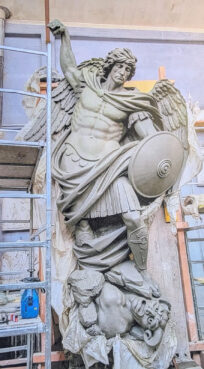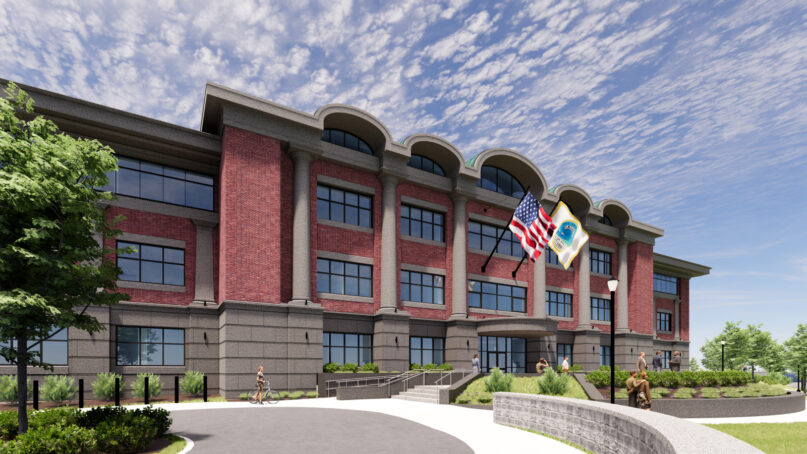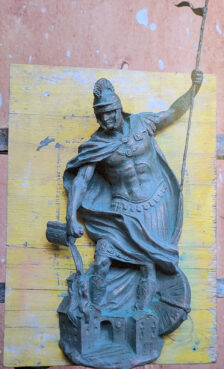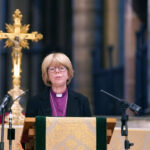QUINCY, Mass. (RNS) — A Massachusetts Superior Court judge has blocked the installation of statues of two Catholic saints at the entrance to a new public safety building in this historic town south of Boston, ruling that the figures might cause anyone coming to the police seeking justice to question whether they have equal standing under the law.
“Victims and witnesses entering such a building often must overcome emotional and psychological hurdles, and intimidation to report crimes and seek police assistance,” wrote Judge William F. Sullivan in granting the plaintiffs who oppose the statuary a preliminary injunction on Tuesday (Oct. 14).
“Central to their concerns is the question of whether the police will treat their claims with the gravity warranted and treat them equally as any other individual, regardless of religious beliefs,” Sullivan said.

A working model for a statue of St. Michael the Archangel to adorn the facade of Quincy’s new public safety building. Sculptor Sergey Eylanbekov designed the work. (Photo courtesy of city of Quincy)
The statues of St. Michael the Archangel, representing the police, and St. Florian, representing firefighters, are 10 feet tall and cost $850,000 each. They have been a source of friction since May, when 15 Quincy residents filed suit with the help of the American Civil Liberties Union. The statues, the suit said, send “an alarming message that those who do not subscribe to the City’s preferred religious beliefs are second-class residents who should not feel safe, welcomed, or equally respected by their government.”
In a statement sent by the ALCU of Massachusetts after the ruling, Conevery Bolton Valencius, one of the plaintiffs, said, “As residents of Quincy, we should not have to walk under such looming religious imagery to seek help from public safety officers or city services.
In his own statement, Mayor Thomas Koch, who is named as a defendant in the case, said of the judge’s ruling, “We chose the statues of Michael and Florian to honor Quincy’s first responders, not to promote any religion. These figures are recognized symbols of courage and sacrifice in police and fire communities across the world.”
The mayor said the city will appeal, with the Becket Fund, a legal group that promotes religious freedom, representing the case pro bono.
The plaintiffs, according to Rachel Davidson, a staff attorney for the ACLU of Massachusetts, include Jews, atheists, Protestants and Catholics.
One of the Jewish plaintiffs, Sheryl LeClair, was cited in the initial suit as being afraid that the statues will engender antisemitism. “As a member of a minority religious group, Ms. LeClair is frightened by the existence and planned installation of these statues and believes that the statues convey the message that she is living in a Christian city and country, and that minority faiths are being ignored, dismissed, and silenced,” the suit said. “She also fears that these statues may exacerbate the current rise in antisemitism.”
About half the residents of Quincy, a majority Catholic city of about 100,000, are white, and a third are Asian Americans, many of whom are Buddhist.
Quincy’s Catholics, Davidson told RNS in May, “are saying they don’t want their religion and their saints associated with violence in this context,” or even the broader idea of policing as good-versus-evil. The depiction of St. Michael stepping on the devil, she noted, reminded some of George Floyd, the Minnesota man killed by being knelt on by a police officer.

A rendering of the new Quincy public safety headquarters. (Image courtesy of KBA Architects)
The statues’ opponents included Ward 5 City Councilor and retired Quincy policeman Dan Minton, who voiced his objection to the statues in February, according to the Quincy Patriot Ledger. “It made me think of brutal force and I don’t want citizens to connect this statue with the way our officers treat anyone,” he wrote on Facebook. He said a better statue idea would be a normal-size police officer welcoming people into the police station.
According to Davidson, a petition opposing the statues got over 1,600 signatures from city residents.
The statues’ sculptor is renowned Russian sculptor Sergey Eylanbekov, who has previously created statues of John and Abigail Adams and John Hancock for Quincy, as well as prominent statues elsewhere.

A model for a statue of St. Florian, the patron saint of firefighters. Sculptor Sergey Eylanbekov designed the work. (Photo courtesy of city of Quincy)
The City Council first approved the design and the funds for construction of the building in 2017. At the time, the council was not told about the statues and no public art was included in any renderings. After the public was made aware of the plans for the statues, the ACLU sent a letter to the council, but the commission for the statues went forward.
Koch told the Patriot Ledger at the time that large projects sometimes evolve. It is unclear how exactly the funds were appropriated for the statues.
The ACLU sued based on Article III of the Massachusetts Declaration of Rights, which states “(A)ll religious sects and denominations, demeaning themselves peaceably, and as good citizens of the commonwealth, shall be equally under the protection of the law; and no subordination of any one sect or denomination to another shall ever be established by law.” It was written by Quincy resident John Adams.



